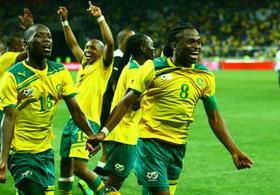 On a day when the Springboks crashed out of the 2011 Rugby World Cup, Bafana Bafana failed to qualify for the 2012 African Nations Cup. After a squalid 0-0 draw against Sierra Leone, the South African players danced to the crowd at Mbombela Stadium in Nelspruit thinking they had done enough to qualify on goal difference.
On a day when the Springboks crashed out of the 2011 Rugby World Cup, Bafana Bafana failed to qualify for the 2012 African Nations Cup. After a squalid 0-0 draw against Sierra Leone, the South African players danced to the crowd at Mbombela Stadium in Nelspruit thinking they had done enough to qualify on goal difference.
But with Bafana, Niger, and Sierra Leone tied with nine points, as the rules of the competition clearly state, it was head-to-head points that settled the score. On that basis, Niger qualified. “I’m confused,” said Bafana coach Pitso Mosimane. Really?
Bafana’s inability to produce on the pitch is a natural reflection of the contradictions in the South African game. On the one hand there is a super-rich and gentrifying Premier Soccer League, but on the other hand there is rotting at multiple levels: adminstration; coaching and youth training; playing grounds in townships and villages; schools; and the female game. What the national team symbolizes in fact is the castle of cards that is South African football. The 2010 World Cup was a tremendous success, but local football continues to deteriorate. What’s needed is structural change and long-term sustainable development for the benefit of the 99 percent of SA football outside the PSL.
Author: Peter Alegi
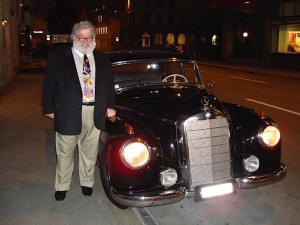
Chuck Blazer, the American General Secretary of CONCACAF, announced he is leaving his post at the end of the year, but will remain on FIFA’s Executive Committee. Blazer, 65, has been milking football for his personal profit and pleasure under the tutelage of CONCACAF and FIFA godfather Jack Warner for two decades. In the build up to the FIFA presidential election earlier in the year, Blazer blew the whistle on a cash-for-votes scheme that led to Blatter being reelected unopposed.
In August, it was also revealed that Blazer was under FBI investigation for tax evasion. Investigative reporter Andrew Jennings — the bane of FIFA crooks’ existence — has written about Blazer’s world of offshore accounts and football-funded lavish lifestyle. “His confidential contract reveals that he hires himself out from his Cayman-based company Sportvertising,” Jennings writes. “It also reveals that he pockets 10% in ‘commissions’ from regional football marketing deals. Last year he picked up nearly $2 million and over the last five years has taken $9.6 million. The sums are recorded in Concacaf accounts – which are not made public – under the heading of ‘Commissions’ – but with no indication he received them.”
A former CONCACAF employee in New York blogged in May about going out with Blazer to strip clubs in Manhattan. The General Secretary treated himself and his staff to “food, strippers, dancers, and massages” paid with “an American Express Card, with CONCACAF and Blazer’s name on it. [. . .] That’s what the General Secretary and Treasurer of CONCACAF, the FIFA Executive from North America, spent the region’s money on . . . regularly,” wrote Mel Brennan.
For Sunil Gulati, US Soccer president, however, “Chuck’s contributions to the sport over the last 30 years are unparalleled. All of us in Concacaf owe him a great debt of gratitude for his sustained efforts in helping to take the sport to where it is today. There is no doubt that he will continue to make an impact in whatever role he chooses.” For the good of the game: the saga continues.
Fútbol and Politics in Chile
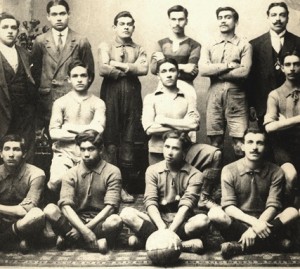 The Football Scholars Forum launches its 2011-12 season this Friday (Sept. 23, 3pm EDT) with Brenda Elsey’s new book Citizens and Sportsmen: Fútbol and Politics in Twentieth-Century Chile (University of Texas Press, 2011). It’s a fresh look at life in twentieth-century Chile through an exploration of how fútbol clubs integrated working-class men into urban politics, connected them to parties, and served as venues of political critique. You can join the conversation online via Skype. For more information visit the FSF website.
The Football Scholars Forum launches its 2011-12 season this Friday (Sept. 23, 3pm EDT) with Brenda Elsey’s new book Citizens and Sportsmen: Fútbol and Politics in Twentieth-Century Chile (University of Texas Press, 2011). It’s a fresh look at life in twentieth-century Chile through an exploration of how fútbol clubs integrated working-class men into urban politics, connected them to parties, and served as venues of political critique. You can join the conversation online via Skype. For more information visit the FSF website.
Inspiration: TMB Panyee Football Club
This short film is based on a true story. In 1986 a football team that lived on a little island in the south of Thailand called Koh Panyee. It’s a floating village in the middle of the sea that has not an inch of soil. The kids here loved to watch football but had nowhere to play or practice. But they didn’t let that stop them. They challenged the norm and have become a great inspiration for new generations on the island.
Juventus Stadium: Changing Calcio
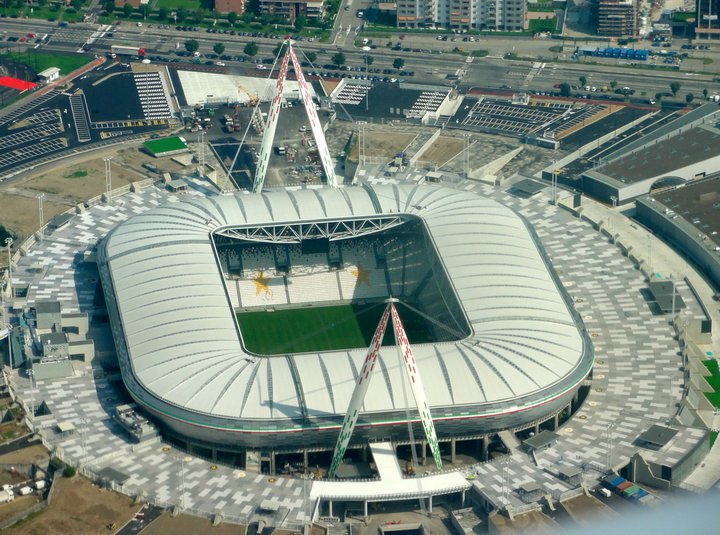
Although I was born and raised in Rome, I support Juve. My choice was based on the need to find a club that could compete with AC Milan and Inter, my older brothers’ favorite teams. I was barely six years old when I first saw Juve play. It was in Perugia (my father’s team) and “we” somehow lost 0-1 thanks to a goal by Renato Curi. As a result, Torino won the scudetto. What a tragedy! But the real tragedy happened a year later when I returned to Perugia hoping for a better Juve performance: Curi collapsed on the pitch and died of a heart attack. Talk about putting things in perspective.
Over the next decade, I watched Juve “under cover” at the Olimpico against Roma and Lazio, and in other cities as well. It could be dangerous. At Marassi stadium, for instance, Genoa’s ultras invaded our curva (end) wielding broken bottles. When all was said and done, a guy two rows in front of me was oozing blood from a stab wound in his leg. Surely it would have been safer in Turin, but as a young teenager living more than 400 miles away it was tough to make the pilgrimage to the Stadio Comunale. And after I moved to the United States in the mid-1980s, it seemed as if I had been sentenced to never attend a Juve “home” match. A victim of contrappasso for my act of betrayal of Roma and Lazio?
The inauguration of Juve’s new stadium is inspiring me to finally make the journey to Turin.
September 8, 2011, heralds the arrival of a new era in Italian football, or calcio as we call it. Juve’s friendly against Notts County — the club responsible for the Old Lady’s adoption of black-and-white kits — marks the first time an Italian club will play in its privately owned stadium.
It is a welcoming football-specific stadium: no track, no moat, no fence. It has a capacity of 41,000 seats and a design similar to many English Premier League grounds. Juve’s stadium provides a long-awaited alternative to overpriced, under-serviced, militarized, and outdated grounds found all over the peninsula. It rises on the ashes of its cursed predecessor, the Delle Alpi. Built on the outskirts of Turin for the 1990 World Cup, Delle Alpi stadium was twice as expensive as originally planned, featured terrible sight lines (largely due to a never-used running track), a bumpy playing surface, and abominably high maintenance costs. In 2003 Juve took it over from the city under a 99-year lease and demolition started in 2008. In the meantime, both Juve and Torino relocated to the downsized ex-Comunale stadium, renamed Olimpico after hosting the inaugural and closing ceremonies for the 2006 Winter Olympics.
Looking at the calendar, I could make the Piedmont derby between Juve and Novara on December 18 . . .
For a virtual tour of the new stadium click here. For videos documenting the construction process go here, here, here, here, here, here, and here.
Narco-Futbol: Gunfire at Stadium in Mexico
Dramatic footage of the shooting outside Corona Stadium in Torreon, Mexico, during the Santos-Morelia match on August 20, 2011. “In Mexico, there are not too many comments in media and newspapers about the event, besides a few comments stating that everybody was and is OK,” reports Football Scholars Forum member Alejandro Gonzales. “On the radio, they are explaining more . . . they have catalogued this event as a metaphor of the current state of affairs in Mexico.”
2014 World Cup Draw: Fans Protest in Rio
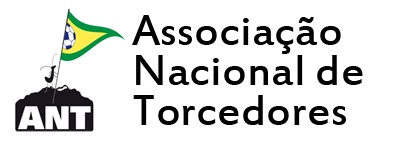
The 2014 World Cup officially got underway today with the qualifying draw in Rio de Janeiro. Simultaneously, the Associação Nacional dos Torcedores de futebol (ANT, the National Association of Football Supporters) organized a demonstration against the World Cup (and the 2016 Olympics). ANT’s call to protest read thusly:
Do you think that the World Cup belongs to us?
Our government continually says that the World Cup and Olympics will bring benefits to Rio de Janeiro and Brazil. But who will benefit? The cost of living and rent are continually on the rise, families are forcibly removed from their homes and street vendors are prevented from working.
More: they are wasting public money on all of these projects and have put forward a law that will hide how much they have spent. To make things worse, the organizers of the World Cup, FIFA and Ricardo Teixeira (the president of the Brazilian Football Federation), are being accused of corruption by multiple sources.
Everything indicates that the World Cup and Olympics are going to repeat, on a larger scale, the history of the 2007 Pan American Games: misappropriation of public funds, unnecessarily large construction projects that become useless after the competition, benefits only for large businesses whose owners are friends of those in power and the violation of the human rights of millions of Brazilians.
The forced removal of families affected by these projects is happening in an arbitrary and violent manner. This situation has already been denounced by the United Nations. Mega-events are being used to install a State of Exception, with the systematic violation of the rule of law.
In this vein, what will be the legacy of the mega-events? The privatization of the city, of health and education? The gentrification of football culture and its stadiums? That private companies will reap profit and benefits with exemptions from taxation and subsidized loans? The profits from the World Cup will be for entrepreneurs, and the debt will be ours. Are we going to allow the mega-event histories of Athens 2004 and South Africa 2010 to repeat themselves?
Join us! Together we will change this trajectory, come and fight! Come kick a ball around with us at the Largo do Machado, the 30th of July beginning at 10am.
Zero evictions!
The city is not merchandise to be bought and sold!
No to the privatization of land and public resources, airports, education and health care!